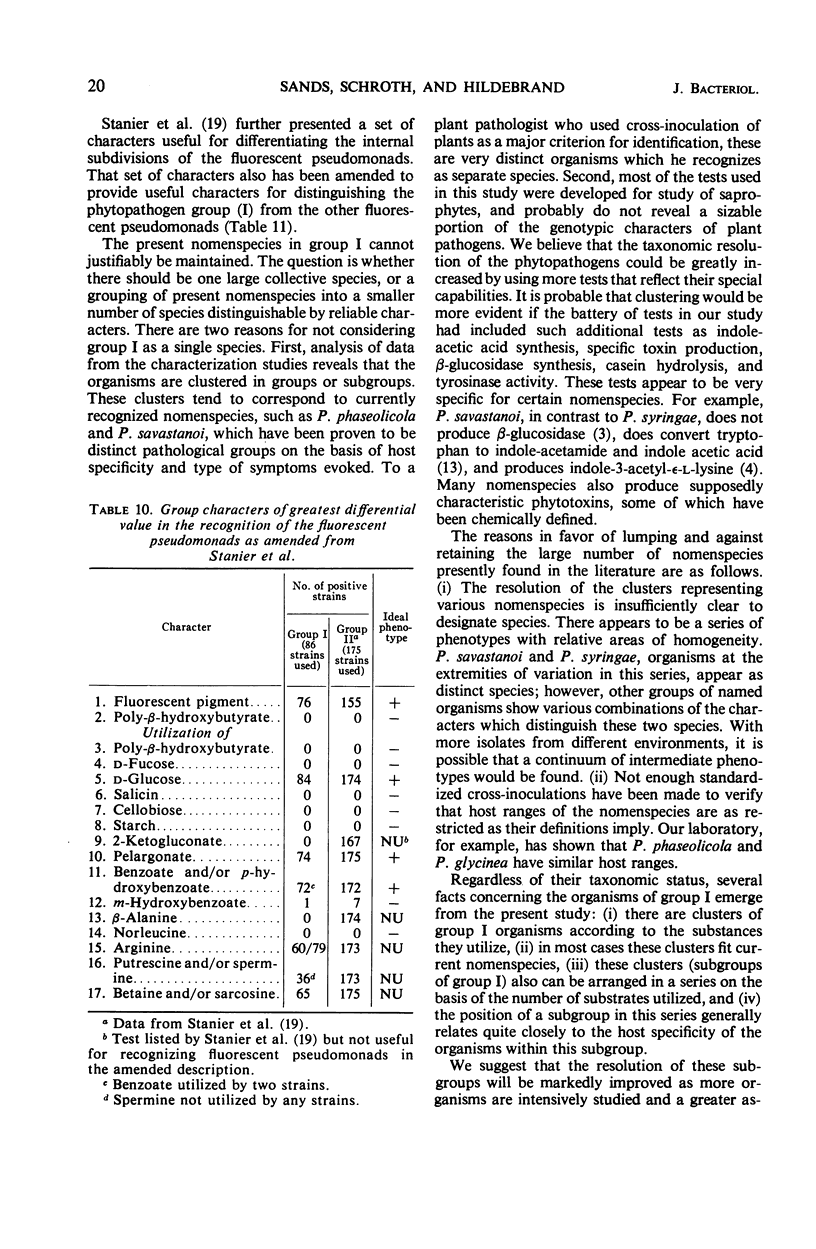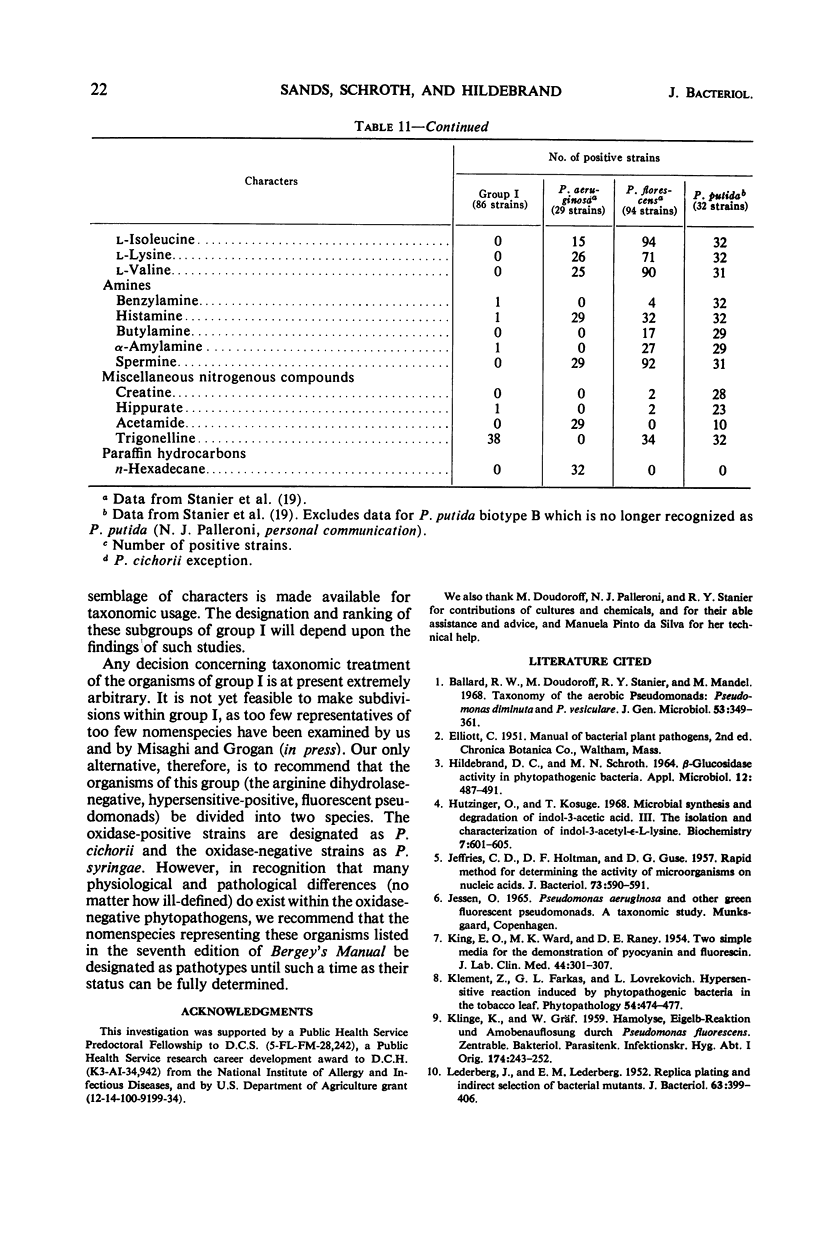Abstract
Phytopathogenic pseudomonads were placed into four major groups on the basis of nutritional and physiological characteristics. Group I consists of 86 strains of phytopathogens distinguishable from other fluorescent pseudomonads by low growth rates, ability to induce hypersensitivity on tobacco, absence of arginine dihydrolase, and relatively limited ranges of carbon sources. Most of these strains cannot utilize benzoate, 2-ketogluconate, spermine, β-alanine, l-isoleucine, l-valine, and l-lysine. Most of the organisms in group I clustered into a small number of subgroups, each of which generally corresponded to a previously recognized nomenspecies. These subgroups differ with respect to the number of substrates used. As a rule, the organisms that utilize the fewest substrates have the most limited host ranges. The fluorescent pseudomonads of group II are arginine dihydrolase-positive and utilize a considerably larger number of carbon sources. Most pathogens of group II are similar to Pseudomonas fluorescens biotype A. Groups III and IV consist of nonfluorescent pseudomonads. These two groups can be distinguished by the number of carbon sources used and by pigmentation. An amended description of the flurescent pseudomonads and their internal subdivision is presented.
Full text
PDF














Selected References
These references are in PubMed. This may not be the complete list of references from this article.
- Ballard R. W., Doudoroff M., Stanier R. Y., Mandel M. Taxonomy of the aerobic psuedomonads: Pseudomonas diminuta and P. vesiculare. J Gen Microbiol. 1968 Oct;53(3):349–361. doi: 10.1099/00221287-53-3-349. [DOI] [PubMed] [Google Scholar]
- Hildebrand D. C., Schroth M. N. beta-Glucosidase Activity in Phytopathogenic Bacteria. Appl Microbiol. 1964 Nov;12(6):487–491. doi: 10.1128/am.12.6.487-491.1964. [DOI] [PMC free article] [PubMed] [Google Scholar]
- Hutzinger O., Kosuge T. Microbial synthesis and degradation of indole-3-acetic acid. 3. The isolation and characterization of indole-3-acetyl-epsilon-L-lysine. Biochemistry. 1968 Feb;7(2):601–605. doi: 10.1021/bi00842a013. [DOI] [PubMed] [Google Scholar]
- JEFFRIES C. D., HOLTMAN D. F., GUSE D. G. Rapid method for determining the activity of microorganisms on nucleic acids. J Bacteriol. 1957 Apr;73(4):590–591. doi: 10.1128/jb.73.4.590-591.1957. [DOI] [PMC free article] [PubMed] [Google Scholar]
- KING E. O., WARD M. K., RANEY D. E. Two simple media for the demonstration of pyocyanin and fluorescin. J Lab Clin Med. 1954 Aug;44(2):301–307. [PubMed] [Google Scholar]
- KLINGE K., GRAF W. Hämolyse, Eigelb-Reaktion und Amöbenauflösung durch Pseudomonas fluorescens; ein Beitrag zur Erkennung der protostatisch-protozide Wirkstoffe bildenden P. fluorescens-Stämme bei der Bodenfiltration. Zentralbl Bakteriol Orig. 1959 Feb;174(3-4):243–252. [PubMed] [Google Scholar]
- LEDERBERG J., LEDERBERG E. M. Replica plating and indirect selection of bacterial mutants. J Bacteriol. 1952 Mar;63(3):399–406. doi: 10.1128/jb.63.3.399-406.1952. [DOI] [PMC free article] [PubMed] [Google Scholar]
- LYSENKO O. Pseudomonas--an attempt at a general classification. J Gen Microbiol. 1961 Jul;25:379–408. doi: 10.1099/00221287-25-3-379. [DOI] [PubMed] [Google Scholar]
- Lelliott R. A., Billing E., Hayward A. C. A determinative scheme for the fluorescent plant pathogenic pseudomonads. J Appl Bacteriol. 1966 Dec;29(3):470–489. doi: 10.1111/j.1365-2672.1966.tb03499.x. [DOI] [PubMed] [Google Scholar]
- MAGIE A. R., WILSON E. E., KOSUGE T. INDOLEACETAMIDE AS AN INTERMEDIATE IN THE SYNTHESIS OF INDOLEACETIC ACID IN PSEUDOMONAS SAVASTANOI. Science. 1963 Sep 27;141(3587):1281–1282. doi: 10.1126/science.141.3587.1281. [DOI] [PubMed] [Google Scholar]
- RHODES M. E. The characterization of Pseudomonas fluorescens with the aid of an electronic computer. J Gen Microbiol. 1961 Jul;25:331–345. doi: 10.1099/00221287-25-3-331. [DOI] [PubMed] [Google Scholar]
- SIERRA G. A simple method for the detection of lipolytic activity of micro-organisms and some observations on the influence of the contact between cells and fatty substrates. Antonie Van Leeuwenhoek. 1957;23(1):15–22. doi: 10.1007/BF02545855. [DOI] [PubMed] [Google Scholar]
- Stanier R. Y., Palleroni N. J., Doudoroff M. The aerobic pseudomonads: a taxonomic study. J Gen Microbiol. 1966 May;43(2):159–271. doi: 10.1099/00221287-43-2-159. [DOI] [PubMed] [Google Scholar]
- Wheelis M. L., Palleroni N. J., Stanier R. Y. The metabolism of aromatic acids by Pseudomonas testosteroni and P. acidovorans. Arch Mikrobiol. 1967;59(1):302–314. doi: 10.1007/BF00406344. [DOI] [PubMed] [Google Scholar]


